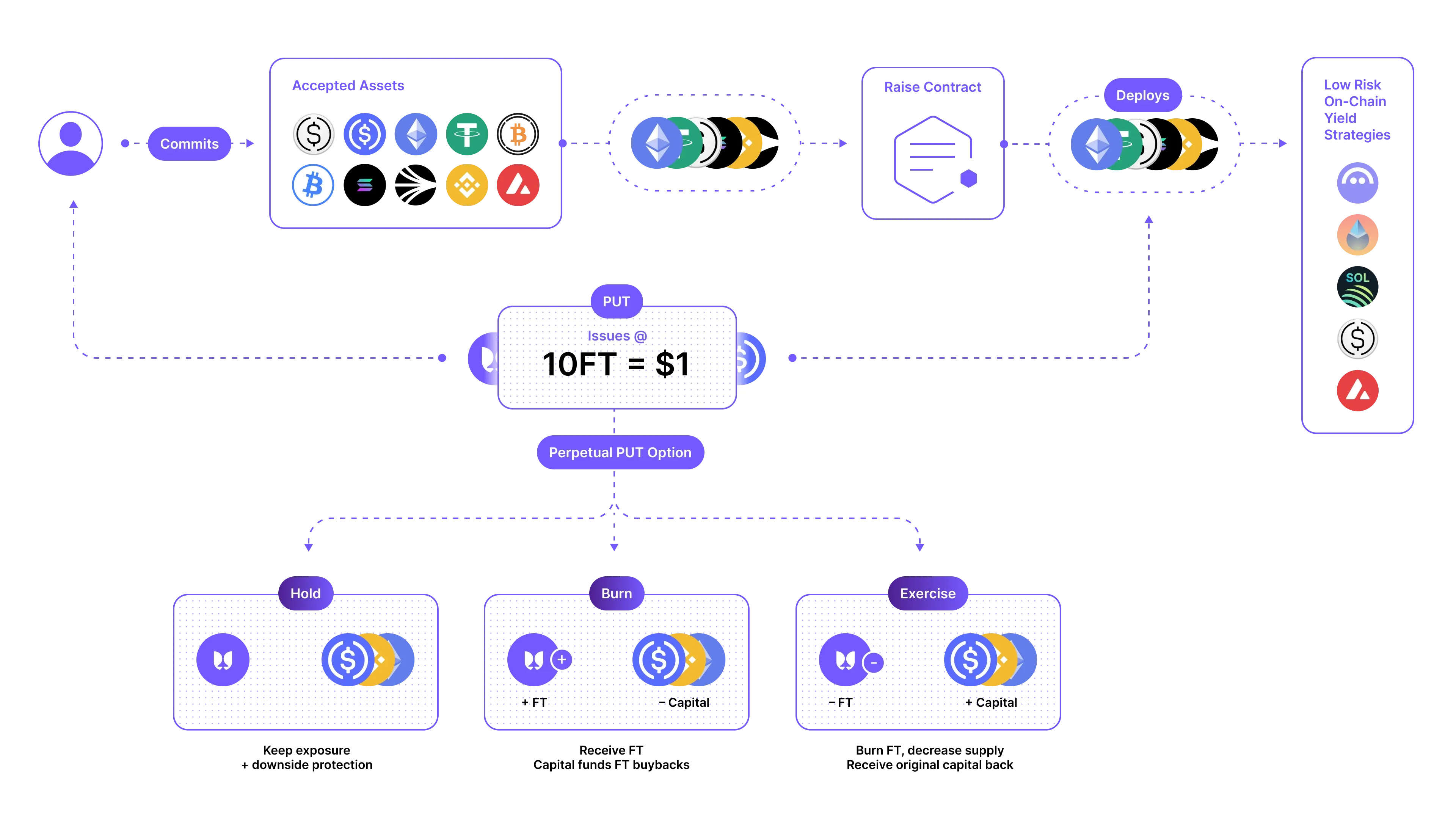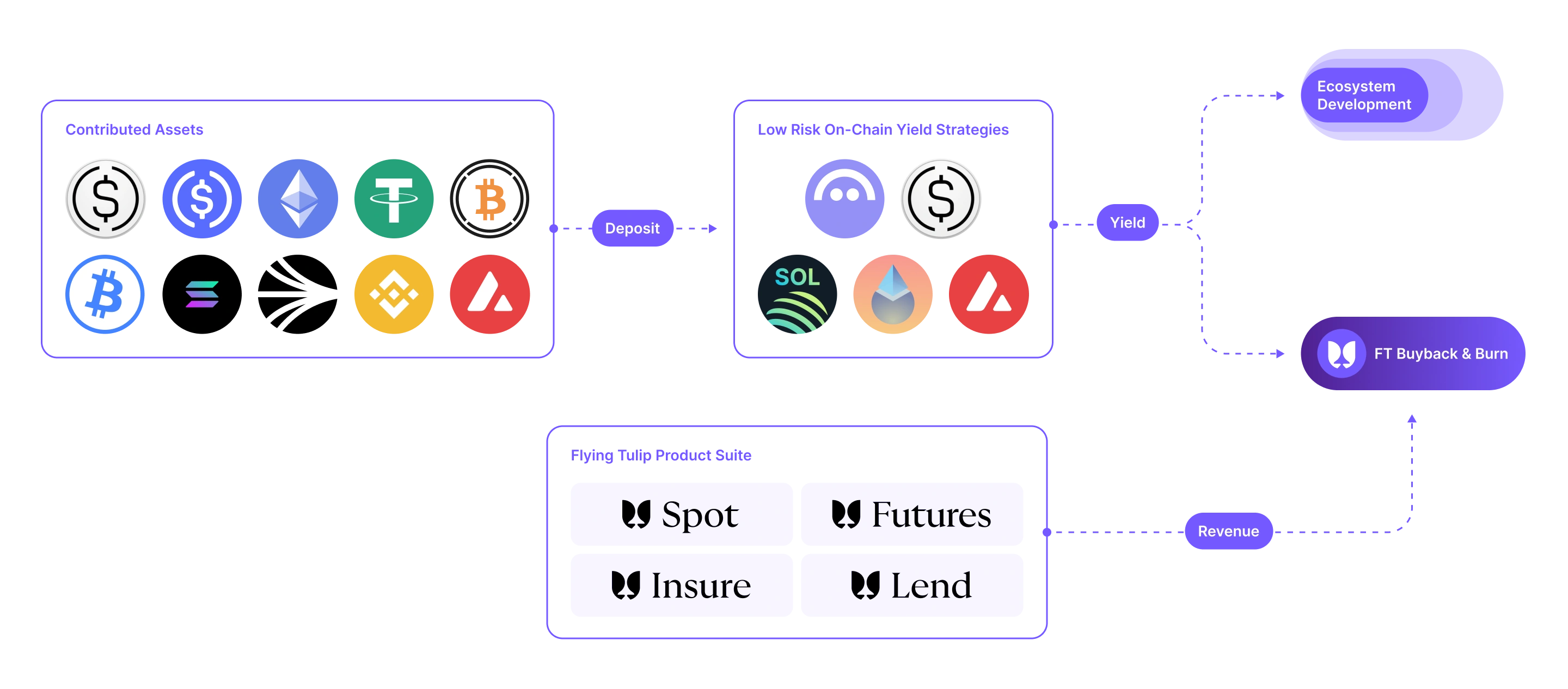Capital Allocation
Flying Tulip is opening its raise to the public to broaden participation in the project’s financing. This follows our $200 million private round and sets the stage for a transparent, on-chain program that’s straightforward and fully auditable.
What You Get to Start
Commit $1 Capital: Receive 10 FT tokens1
Fixed Supply, No Inflation, Only Burns
FT has a maximum supply of 10 billion tokens. We mint only what we actually raise; if $500 million is contributed, exactly 5 billion FT are created and distributed. When we reach 10 billion FT tokens, we’ll close. Straightforward and simple. There is no vesting, no future inflation, and no additional minting later on in the future.
Contributions are made through flyingtulip.com and settle to the Investment Contract.
Note: The address for the Investment Contract will be finalized in‑app. Always verify the address shown in the Invest UI before sending funds.
When your contribution settles, your FT is issued into a Perpetual PUT that attaches a standing, on-chain redemption right to your primary-issued tokens. You can keep this right attached, divest at par, or unlock the FT and continue without the Perpetual PUT, whichever best fits your plan or reaction to market conditions.
Your Perpetual PUT Position - How Does it Work?


Perpetual PUT Option lifecycle.
Market buyers: FT purchased on the open market does not include a Perpetual PUT. The Perpetual PUT is attached only to FT issued to primary contributors during the Private and Public Capital Allocation.
When your contribution mints FT, those tokens are locked into your Perpetual PUT. From there, you always have three choices (and you can mix them over time in any proportions you like):
1. Hold: Keep your position and capital protection active
Do nothing and keep your redemption right. You participate in all FT appreciation while maintaining the ability to exit at par whenever you choose. There are no trigger dates, no cliffs, the right is evergreen.
2. Divest: Recover original asset
Divest some or all of the exact asset and amount you originally committed. Divests can be partial and repeated.
Par asset return. Divest returns the same asset and the same amount you originally contributed.
So if you contributed 1,000 USDC and received a Perpetual PUT with 10,000 FT, then you can divest your Perpetual PUT for 1,000 USDC.
Or, if you contributed 2 ETH (1 ETH = $3,840) and received a Perpetual PUT with 76,800 FT, then you can divest your Perpetual PUT for 2 ETH.
Note: You get back the exact asset and amount you originally put in.
3. Withdraw: Access your FT and destroy your Perpetual PUT
If you want to directly hold, trade, or use your FT tokens, you can withdraw them. This invalidates the Perpetual PUT on that portion forever.
The original backing capital that was reserved for your redemption is released and used by the protocol to fund operations, market buyback, and burns of FT, benefiting everyone who remains.
- Divest: You get your capital back; divested FT are returned.
- Withdraw: You keep your FT; released capital buys and burns FT from the market
Divest vs. Withdraw - at a glance
Note: FT tokens bought on the open market do not include a Perpetual PUT.
| Function | Divest (Par Return) | Withdraw (Unlock FT) |
|---|---|---|
| In plain English | You get back the exact asset and amount you originally put in. Your Perpetual PUT is used on that portion, and the backing is returned to you (no buyback). | You take a portion or all of your FT out of the Perpetual PUT but your Perpetual PUT on that portion is invalidated. The reserved backing is released and used by the protocol to fund market buyback and burns of FT. |
Note: Withdraw triggers buybacks & burns funded by the released backing.
USDC Example: Divest at par Contribute 1,000 USDC → receive 10,000 FT. Later divest 10,000 FT → receive 1,000 USDC.
USDC Example: Withdraw & sell above par: Contribute 1,000 USDC → receive 10,000 FT. Withdraw 10,000 FT (PUT invalidated), then sell on the market at, say, $0.15; the released backing is used by the protocol to fund market buyback and burns of FT over time.
ETH Example: Divest at par Contribute 2 ETH → receive 76,800 FT (1 ETH = $3,840). Later divest 76,800 FT → receive 2 ETH.
ETH Example: Withdraw & sell above par: Contribute 2 ETH → receive 76,800 FT (1 ETH = $3,840). Withdraw 76,800 FT (PUT invalidated), then sell on the market at, say, $0.15; the released backing is used by the protocol to fund market buyback and burns of FT over time.
Note: You get back the exact asset and amount you originally invested.
Illustrative scale effects. If a meaningful share of holders withdraw, released backing can retire large amounts of FT via buybacks. For example, at a $0.10 average buyback price, $100m of released backing can retire roughly 1.0 billion FT; $250m can retire ~2.5 billion FT; $500m can retire ~5.0 billion FT.
Selling or transferring FT
To sell or transfer FT you first withdraw it from your Perpetual PUT. Withdraw permanently invalidates the Perpetual PUT on that portion. The backing that had reserved your redemption is released to fund market buyback and burns of FT. The buyer on the market does not receive a Perpetual PUT.
Distributions to users
A portion of protocol revenue/fees is used to buy FT on the market and distribute those tokens to users as defined by product‑level programs (separate from burns). Exact shares and schedules are shown in each product’s UI and on the Token page. Revenue‑funded burns still govern team/foundation unlocks (40:20:20:20)
Where Your Capital Goes


Contributed capital allocation flow.
Less Risk. More Transparency.
Committed capital itself is never spent. While your Perpetual PUT is open, contributed assets are kept liquid and deployed into low‑risk, on-chain yield with no leverage and no bridging (e.g., Aave v3 for major stables, stETH for ETH, jupSOL for SOL, AVAX staking for AVAX, sUSDe for USDe). This keeps the program conservative and unwind‑friendly. Prioritizing safety and liquidity may earn lower yields than riskier strategies, by design, so that redemptions can be honored quickly in all conditions.
Priority of backing yield:
- Ecosystem development first. The first call on the backing yield is to fund the ongoing development of the ecosystem, infrastructure and operations.
- All surplus to buyback & burn. Any remaining backing yield after the ecosystem budget is met is used for continuous buyback‑and‑burn of FT.
Protocol revenue and fees from Flying Tulip’s entire suite of products (ftUSD, settlement rails, lending, derivatives, spot, permissionless markets, insurance) are also routed to buybacks and burns; and govern the unlocking of Foundation/Team/Ecosystem/Incentives allocations using a 40:20:20:20 split.
- Buybacks funded by revenue unlock.
- Buybacks funded solely by backing yield do not trigger unlocks.
For the full backtests, formulas, and sensitivity math, see the Technical Appendix.
Safety first (and the trade‑off):
Backing capital is kept in safe, liquid positions (no leverage, no bridging) so redemptions can be honored quickly. This may earn a lower yield than riskier strategies, by design. In synchronized redemption waves, some positions (e.g., LST withdrawals) can introduce timing delays; we size and diversify to minimize this.
Unlock Mechanics
Unlocks are revenue‑linked. Buybacks funded by project revenue unlock Foundation/Team/Ecosystem/Incentives 1:1 (40:20:20:20). Buybacks funded only by backing interest do not unlock anything; they just reduce supply.
How to Participate
- Visit flyingtulip.com and connect a supported wallet.
- Choose an accepted asset (addresses below) and contribute to the Investment Contract.
- Receive FT at 10 FT per $1 contributed, issued into your Perpetual PUT.
- Manage your position over time: Hold, Divest, or Withdraw, all on-chain and reflected in the public buyback/burn ledger.
Why This Structure Works
100% Capital Protection.
The structure is designed to reduce investor risk, preserve capital, and align incentives:
- The perpetual PUT or evergreen redemption right provides a floor at par, with no cliffs or lockups
- Backing capital works continuously in conservative strategies rather than being spent, so that value accrues immediately
- Revenue-linked operations and costs ensure team and foundation liquidity expands only when real cash flow is buying back FT, not up front
- Withdrawals create path‑dependent scarcity: released backing funds, additional buybacks for the benefit of remaining holders.
Risks to understand
- Liquidity timing during stress. Some backing positions (e.g., stETH, jupSOL, AVAX) may require exit queues or unbonding. Exposures are sized for timely unwinds, but synchronized exits can still slow settlement.
- Peg/basis and yield variability. Components like sUSDe (basis/funding dependent) and newer stables can experience yield compression or adverse basis moves.
- Protocol/validator risk. Smart‑contract, validator, and MEV‑economics risks exist in all integrated systems (Aave, LSTs, staking).
- Regulatory risk. Policy changes around stablecoins and staking can affect the backing mix or operations.
- Investor trade‑offs. Secondary buyers do not receive a Perpetual PUT. Primary buyers who hold near par for long periods may experience opportunity cost versus higher‑risk strategies.
- Redemption timing. In heavy redemption windows, some backing components (e.g., LST exits, validator unbonding) can introduce delays. Allocations are sized for fast unwinds, but synchronized exits can still slow settlement
Note: This page is informational and not investment advice. Yields are variable and not guaranteed.
Accepted Assets & Chains
Note: Always confirm these addresses in the Invest UI at the time of contribution.
Ethereum
| Token | Address |
|---|---|
| USDT | 0xdAC17F958D2ee523a2206206994597C13D831ec7 |
| USDC | 0xA0b86991c6218b36c1d19D4a2e9Eb0cE3606eB48 |
| USDS | 0xdC035D45d973E3EC169d2276DDab16f1e407384F |
| USDtb | 0xC139190F447e929f090Edeb554D95AbB8b18aC1C |
| USDe | 0x4c9EDD5852cd905f086C759E8383e09bff1E68B3 |
| WETH | 0xC02aaA39b223FE8D0A0e5C4F27eAD9083C756Cc2 |
Avalanche
| Token | Address |
|---|---|
| wAVAX | 0xB31f66AA3C1e785363F0875A1B74E27b85FD66c7 |
| USDC | 0xB97EF9Ef8734C71904D8002F8b6Bc66Dd9c48a6E |
| USDT | 0x9702230A8Ea53601f5cD2dc00fDBc13d4dF4A8c7 |
Sonic
| Token | Address |
|---|---|
| wS | 0x039e2fB66102314Ce7b64Ce5Ce3E5183bc94aD38 |
| USDC | 0x29219dd400f2Bf60E5a23d13Be72B486D4038894 |
Base
| Token | Address |
|---|---|
| USDC | 0x833589fCD6eDb6E08f4c7C32D4f71b54bdA02913 |
| WETH | 0x4200000000000000000000000000000000000006 |
BNB Chain
| Token | Address |
|---|---|
| WBNB | 0xbb4CdB9CBd36B01bD1cBaEBF2De08d9173bc095c |
Solana
| Token | Address |
|---|---|
| USDC | EPjFWdd5AufqSSqeM2qN1xzybapC8G4wEGGkZwyTDt1v |
| wSOL | So11111111111111111111111111111111111111112 |
FAQ
Do I have a lockup?
No. There is no vesting and no cliff. Your FT is issued into your Perpetual PUT; you can Hold, Divest, or Withdraw at any time.
What’s the difference between Divest and Withdraw?
Divest returns your original asset at par. Withdraw unlocks your FT (Perpetual PUT invalidated) and uses the released backing to buy back & burn FT on the market.
Do buybacks always unlock tokens for the team/foundation?
No. Only revenue‑funded buybacks unlock Foundation/Team/Ecosystem/Incentives (40:20:20:20) one‑for‑one. Backing‑yield‑only buybacks do not trigger unlocks.
Where can I see the math?
See the Technical Appendix (link below) for full backtests, formulas, and scenario tables.
Do I need a vote to divest?
No. The Perpetual PUT is an on-chain, programmatic right. Exercising it requires no governance vote, and a vote cannot revoke the right on existing primary-issued FT.
What is the difference between Divest vs. Withdraw?
Divest returns the exact asset and amount you originally committed.
Withdraw invalidates the Perpetual PUT; the reserved backing is then used by the protocol to fund market buyback and burns of FT. Buyers of FT on the market do not receive a Perpetual PUT
Do secondary buyers receive the Perpetual PUT Option?
FT purchased on the open market does not include a Perpetual PUT. Only primary FT issued in the Capital Allocation has the Perpetual PUT
Why withdraw instead of divest?
If FT trades above your original price, withdrawing and then selling can realize more than par, but you lose the Perpetual PUT on what you withdraw. Divesting always returns exactly par, regardless of market price.
Footnotes
-
You exchange accepted on-chain assets for FT at a fixed rate of 10 FT per $1
(implied price: $0.10) ↩